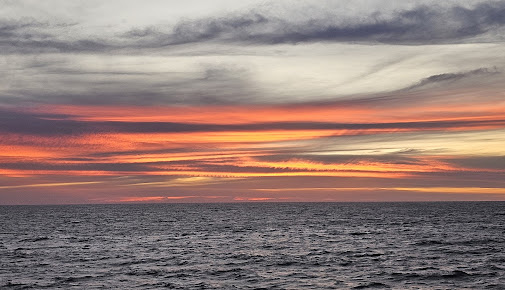When I made my way to the Sky Lounge this morning, Viking Sky had just sailed under the Atlantic Bridge, which we had driven across yesterday. We were waiting to pass through the Gatun Locks and into the Panama Canal. Neither Tim nor I had ever been through the canal, and we were excited to make what would prove to be a memorable journey.
 |
| The Atlantic Bridge Under Threatening Skies |
The Panama Canal is about 48 miles long and crosses the Isthmus of Panama at its narrowest stretch, thereby connecting the Atlantic and Pacific Oceans. Locks at the Atlantic side lift ships 85 feet to Gatun Lake, while locks at the Pacific end then lower the ships to sea level. The Panama Canal is one of the largest and most complex engineering projects ever undertaken.
A French company was the first to attempt the construction of a canal, beginning in 1881, but its efforts were unsuccessful. The United States took over the project in 1904 and opened the canal in 1914. The Unites States continued to control the canal and surrounding Panama Canal Zone until its handover to Panama in 1977. The Panamanian government assumed full control in 1999.
The Panama Canal is the only place in the world where a ship's master gives full command to the Panama Canal Authority pilot. Mules and tugs are used to guide ships through the canal locks. Tugboats pull, or push, ships through the lock's entry using a tow line. Electric locomotives, or mules, run along the lock walls to keep ships centered in the locks.
I was perhaps most excited to go through the Gatun Locks, since this was all new to me. The Gatun Locks, a three-stage flight of locks, lifted us to the level of Gatun Lake, about 87 feet above sea level. Despite a brief rain shower, the weather mostly cooperated for us, and it wasn’t even too hot and humid on deck. I stayed outside for this entire transit and then finally moved to the World Café for breakfast as we sailed into the massive Gatun Lake.
 |
| In and Out of the Gatun Locks |
 |
| Looking Back toward the Atlantic Bridge While in the Gatun Locks |
 |
| Tugs and Electric Locomotives, or Mules, Helped to Guide Our Ship |
 |
| The Only Photo I Took of Gatun Lake |
While we were crossing Gatun Lake, I took a break from the canal. Before long, it was lunchtime, where the World Café was hosting a Caesar Salad Station. Shore Excursion Manager Chantelle and her Assistant had been roped into helping serve the salad.
 |
| A Yummy Caesar Salad, Mine with Salmon |
In the afternoon, we entered the Chagres River and then passed through the Culebra Cut, which slices through the Andes Mountains and crosses the Continental Divide. We could see the terraces along the banks of the canal, a method that helps prevent landslides, as we sailed under the Centennial Bridge.
 |
| Approaching the Centennial Bridge - Note the Terraces along the Banks |
As we neared the end of our journey, we entered the Pedro Miguel Lock, which lowered us 30 feet to Miraflores Lake.
 |
| Pedro Miguel Lock |
I wasn’t expecting to reach the two-stage Miraflores Locks so quickly, and I was in our room when we approached the locks. So, I watched the initial passage on the Bridge Cam, which provided a great view. I did manage to get out on deck to watch as we were lowered to sea level and as the final lock opened.
 |
| Entering the Miraflores Locks |
 |
| In the Miraflores Locks |
 |
| Getting Ready to Exit the Miraflores Locks |
We knew that we had almost reached the Pacific Ocean when we sailed under the Bridge of the Americas. We could see the Panama City skyline in the distance, as well as Frank Gehry's Biodiversity Museum, a structure that I had been looking forward to seeing.
 |
| Getting Ready to Sail Under the Bridge of the Americas |
 |
| Panama City Skyline and Frank Gehry's Biodiversity Museum |
 |
| Into the Pacific Ocean, with a Lineup of Ships Waiting to Transit the Canal |
After almost ten hours, the transit through the Panama Canal was complete. It was an amazing experience.





















































